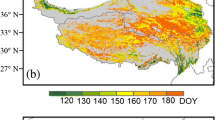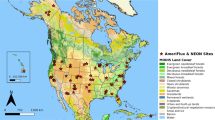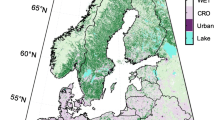Abstract
Ecosystem phenology, i.e., the timing of key biological events, is often considered as both a witness and an actor of climate change. Phenological interannual variations and decadal changes reflect climate variability and trends. Deciduous plant phenology also directly influences the carbon, water, and energy exchanges of the ecosystem with the atmosphere. In the northern forests, a trend to earlier spring has been widely reported, often based on remote sensing methods. This trend is suggested to explain a part of the residual carbon sink. However methodological issues, especially related to the combined effects of the vegetation and of the snow cover seasonal changes on the remote sensing signal, were found to affect the results. This chapter describes a remote sensing green-up retrieval method designed to avoid signal contamination by snow. The result validation with ground observations showed that the method catches the interannual variations in phenology of the plant community. Changes in the 1998–2017 period are analyzed and positioned in a longer term. This shows that the most persistent feature over the last decades is a large-scale shift in the green-up date at the end of the 1980s, and that the green-up date has not recovered yet to its status prior to 1987. Finally the green-up date maps were used to represent phenology in the northern ecosystem carbon budget simulations. No unidirectional effect of phenological changes in the annual carbon balance could be identified because of a complex interplay between vegetation, water resources and climate.
This chapter is dedicated to the memory of Rikie Suzuki.
Access this chapter
Tax calculation will be finalised at checkout
Purchases are for personal use only
Similar content being viewed by others
References
Badeck F-W, Bondeau A, Böttcher K, Doktor D, Lucht W, Schaber J, Sitch S (2004) Responses of spring phenology to climate change. New Phytol 162:295–309
Baldocchi D, Falge E, Gu L et al (2001) FLUXNET: a new tool to study the temporal and spatial variability of ecosystem-scale carbon dioxide, water vapor, and energy flux densities. Bull Am Meteor Soc 82:2415–2434
Bartholomé E, Belward AS (2005) GLC2000: A new approach to global land cover map** from earth observation data. Int J Remote Sens 26:1959–1977
Beaubien EG, Hamann A (2011a) Plant phenology networks of citizen scientists: recommendations from two decades of experience in Canada. Int J Biometeorol 55:833–841
Beaubien E, Hamann A (2011b) Spring flowering response to climate change between 1936 and 2006 in Alberta, Canada. Bioscience 61:514–524
Beck PSA, Atzberger C, Høgda KA, Johansen B, Skidmore AK (2006) Improved monitoring of vegetation dynamics at very high latitudes: a new method using MODIS NDVI. Remote Sens Environ 100:321–334
Bellard C, Bertelsmeier C, Leadley P, Thuiller W, Courchamp F (2012) Impacts of climate change on the future of biodiversity. Ecol Lett 15:365–377
Bo**ski S, Verstraete M, Peterson TC, Richter C, Simmons A, Zemp M (2014) the concept of essential climate variables in support of climate research, applications, and policy. Bull Am Meteor Soc 95:1431–1443
Both C, Van Asch M, Bijlsma RG, Van Den Burg AB, Visser ME (2009) Climate change and unequal phenological changes across four trophic levels: constraints or adaptations? J Anim Ecol 78:73–83
Buermann JL (2016) Climate-driven shifts in continental net primary production implicated as a driver of a recent abrupt increase in the land carbon sink. Biogeosciences 13:1597–1607
Buermann M (2013) Earlier springs decrease peak summer productivity in North American boreal forests. Environ Res Lett 8
Chuine I (2010) Why does phenology drive species distribution? Philosophical Transactions of the Royal Society B: Biological Sciences 365:3149–3160
Colombo UM (2011) Phenological monitoring of grassland and larch in the Alps from Terra and Aqua MODIS images. Italian J Remote Sens/Rivista Italiana di Telerilevamento 43:83–96
Dantec-Nédélec S (2017) Evaluation multi-échelle des bilans d’énergie et d’eau du modèle ORCHIDEE sur la Sibérie et leur réponse à l’évolution du climat. Paris Saclay
Delbart N, Beaubien E, Kergoat L, Le Toan T (2015) Comparing land surface phenology with leafing and flowering observations from the PlantWatch citizen network. Remote Sens Environ 160:273–280
Delbart N, Kergoat L, Le Toan T, Lhermitte J, Picard G (2005) Determination of phenological dates in boreal regions using normalized difference water index. Remote Sens Environ 97:26–38
Delbart N, Le Toan T, Kergoat L, Fedotova V (2006) Remote sensing of spring phenology in boreal regions: a free of snow-effect method using NOAA-AVHRR and SPOT-VGT data (1982–2004). Remote Sens Environ 101:52–62
Delbart N, Picard G (2007) Modeling the date of leaf appearance in low-arctic tundra. Glob Change Biol 13:2551–2562
Delbart N, Picard G, Le Toan T, Kergoat L, Quegan S, Woodward I, Dye D, Fedotova V (2008) Spring phenology in boreal Eurasia over a nearly century time scale. Glob Change Biol 14:603–614
Dethier BE, Ashley MD, Blair BO, Caprio JM, Hopp RJ, Rouse Jr, J (1973) Phenology satellite experiment.[detection of brown wave and green wave in north-south corridors of United States]
Duchemin B, Goubier J, Courrier G (1999) Monitoring phenological key stages and cycle duration of temperate deciduous forest ecosystems with NOAA/AVHRR data. Remote Sens Environ 67:68–82
Dunn AH, de Beurs KM (2011) Land surface phenology of North American mountain environments using moderate resolution imaging spectroradiometer data. Remote Sens Environ 115:1220–1233
Dye DG, Tucker CJ (2003) Seasonality and trends of snow-cover, vegetation index, and temperature in northern Eurasia. Geophys Res Lett 30:1–58
Forkel M, Carvalhais N, Rödenbeck C, Keeling R, Heimann M, Thonicke K, Zaehle S, Reichstein M (2016) Enhanced seasonal CO2 exchange caused by amplified plant productivity in northern ecosystems. Science 351:696–699
Gonsamo A, Chen JM (2016) Circumpolar vegetation dynamics product for global change study. Remote Sens Environ 182:13–26
Gonsamo C (2013) Citizen science: linking the recent rapid advances of plant flowering in Canada with climate variability. Sci Rep 3
Goulden ML, Wofsy SC, Harden JW, Trumbore SE, Crill PM, Gower ST, Fries T, Daube BC, Fan S-M, Sutton DJ, Bazzaz A, Munger JW (1998) Sensitivity of boreal forest carbon balance to soil thaw. Science 279:214–217
Graven HD, Keeling RF, Piper SC, Patra PK, Stephens BB, Wofsy SC, Welp LR, Sweeney C, Tans PP, Kelley JJ, Daube BC, Kort EA, Santoni GW, Bent JD (2013) Enhanced Seasonal Exchange of CO2 by Northern Ecosystems Since 1960. Science 341:1085–1089
Grippa M, Mognard N, Le Toan T (2005) Comparison between the interannual variability of snow parameters derived from SSM/I and the Ob river discharge. Remote Sens Environ 98:35–44
Guan S-J (2014) Deriving vegetation phenological time and trajectory information over africa using seviri daily LAI. IEEE Trans Geosci Remote Sens 52:1113–1130
Guimberteau M, Zhu D, Maignan F, Huang Y, Chao Y, Dantec-Nédélec S, Ottlé C, Jornet-Puig A, Bastos A, Laurent P (2018) ORCHIDEE-MICT (v8. 4.1), a land surface model for the high latitudes: model description and validation. Geosci Model Develop 11:121
Guyon J-P (2011) Monitoring elevation variations in leaf phenology of deciduous broadleaf forests from SPOT/VEGETATION time-series. Remote Sens Environ 115:615–627
Hakkinen R, Linkosalo T, Hari P (1995) Methods for combination phenological time series: Application to bud burst in birch (Betula pendula) in central Finland for the period 1896–1955. Tree Physiol 15:721–726
Helman D (2018) Land surface phenology: What do we really “see” from space? Sci Total Environ 618:665–673
Hinzman LD, Bettez ND, Bolton WR et al (2005) Evidence and implications of recent climate change in Northern Alaska and other Arctic regions. Clim Change 72:251–298
Holben BN (1986) Characteristics of maximum-value composite images from temporal AVHRR data. Int J Remote Sens 7:1417–1434
IPCC (2013) Climate change 2013: The physical science basis. contribution of working group i to the fifth assessment report of the intergovernmental panel on climate change. Cambridge University Press, Cambridge, United Kingdom and New York, NY, USA
James ME, Kalluri SNV (1994) The pathfinder AVHRR land data set: an improved coarse resolution data set for terrestrial monitoring. Int J Remote Sens 15:3347–3363
** H, Eklundh L (2014) A physically based vegetation index for improved monitoring of plant phenology. Remote Sens Environ 152:512–525
** H, Jönsson AM, Bolmgren K, Langvall O, Eklundh L (2017) Disentangling remotely-sensed plant phenology and snow seasonality at northern Europe using MODIS and the plant phenology index. Remote Sens Environ 198:203–212
Justice BO, Holben BN, Gwynne MD (1986) Monitoring east african vegetation using AVHRR data. Int J Remote Sens 7:1453–1474
Justice CO, Townshend JRG, Holben AN, Tucker CJ (1985) Analysis of the phenology of global vegetation using meteorological satellite data. Int J Remote Sens 6:1271–1318
Keeling CD, Chin JFS, Whorf TP (1996) Increased activity of northern vegetation inferred from atmospheric CO2 measurements. Nature 382:146–149
Keenan AD (2015) The timing of autumn senescence is affected by the timing of spring phenology: Implications for predictive models. Glob Change Biol 21:2634–2641
Kiers ET, Palmer TM, Ives AR, Bruno JF, Bronstein JL (2010) Mutualisms in a changing world: an evolutionary perspective. Ecol Lett 13:1459–1474
Krinner G, Viovy N, de Noblet-Ducoudré N, Ogée J, Polcher J, Friedlingstein P, Ciais P, Sitch S, Prentice IC (2005) A dynamic global vegetation model for studies of the coupled atmosphere-biosphere system. Global Biogeochem Cycles 19:1–33
Le Quéré C, Peters GP, Andres RJ et al (2014) Global carbon budget 2013. Earth Syst Sci Data 6:235–263
Liang L, Schwartz MD, Fei S (2011) Validating satellite phenology through intensive ground observation and landscape scaling in a mixed seasonal forest. Remote Sens Environ 115:143–157
Liu Q, Fu YH, Zhu Z, Liu Y, Liu Z, Huang M, Janssens IA, Piao S (2016) Delayed autumn phenology in the Northern Hemisphere is related to change in both climate and spring phenology. Glob Change Biol 22:3702–3711
Menzel A (2000) Trends in phenological phases in Europe between 1951 and 1996. Int J Biometeorol 44:76–81
Meroni M, Verstraete MM, Rembold F, Urbano F, Kayitakire F (2014) A phenology-based method to derive biomass production anomalies for food security monitoring in the Horn of Africa. Int J Remote Sens 35:2472–2492
Misra G, Buras A, Menzel A (2016) Effects of different methods on the comparison between land surface and ground phenology—a methodological case study from South-Western Germany. Remote Sen 8
Morin X, Viner D, Chuine I (2008) Tree species range shifts at a continental scale: new predictive insights from a process-based model. J Ecol 96:784–794
Morisette JT, Richardson AD, Knapp AK, Fisher JI, Graham EA, Abatzoglou J, Wilson BE, Breshears DD, Henebry GM, Hanes JM, Liang L (2009) Tracking the rhythm of the seasons in the face of global change: Phenological research in the 21st century. Front Ecol Environ 7:253–260
Moulin S, Kergoat L, Viovy N, Dedieu G (1997) Global-scale assessment of vegetation phenology using NOAA/AVHRR satellite measurements. J Clim 10:1154–1170
Myneni RB, Keeling CD, Tucker CJ, Asrar G, Nemani RR (1997) Increased plant growth in the northern high latitudes from 1981 to 1991. Nature 386:698–702
Myneni RB, Tucker CJ, Asrar G, Keeling CD (1998) Interannual variations in satellite-sensed vegetation index data from 1981-1991. J Geophys Res D: Atmos 103:6145–6160
Ottlé C, Lescure J, Maignan F, Poulter B, Wang T, Delbart N (2013) Use of various remote sensing land cover products for plant functional type map** over Siberia. Earth Syst Sci Data 5:331–348
Park T, Ganguly S, Tømmervik H, Euskirchen ES, Høgda K-A, Karlsen SR, Brovkin V, Nemani RR, Myneni RB (2016) Changes in growing season duration and productivity of northern vegetation inferred from long-term remote sensing data. Environ Res Lett 11:084001
Parmentier FJW, Van Der Molen MK, Van Huissteden J, Karsanaev SA, Kononov AV, Suzdalov DA, Maximov TC, Dolman AJ (2011) Longer growing seasons do not increase net carbon uptake in the northeastern Siberian tundra. J Geophys Res: Biogeosci 116
Parmesan C, Yohe G (2003) A globally coherent fingerprint of climate change impacts across natural systems. Nature 421:37–42
Peel MC, Finlayson BL, McMahon TA (2007) Updated world map of the Köppen-Geiger climate classification. Hydrol Earth Syst Sci 11:1633–1644
Pennec A, Gond V, Sabatier D (2011) Tropical forest phenology in French Guiana from MODIS time series. Remote Sens Lett 2:337–345
Pereira HM, Ferrier S, Walters M et al (2013) Essential biodiversity variables. Science 339:277–278
Picard G, Quegan S, Delbart N, Lomas MR, Le Toan T, Woodward FI (2005) Bud-burst modelling in Siberia and its impact on quantifying the carbon budget. Glob Change Biol 11:2164–2176
Post E, Forchhammer MC (2008) Climate change reduces reproductive success of an Arctic herbivore through trophic mismatch. Philos Trans R Soc Lond B: Biol Sci 363:2367–2373
Post E, Forchhammer MC, Bret-Harte MS, Callaghan TV, Christensen TR, Elberling B, Fox AD, Gilg O, Hik DS, Høye TT (2009) Ecological dynamics across the Arctic associated with recent climate change. Science 325:1355–1358
Post E, Pedersen C, Wilmers CC, Forchhammer MC (2008) Warming, plant phenology and the spatial dimension of trophic mismatch for large herbivores. Proc R Soc Lond B: Biol Sci 275:2005–2013
Pouliot I (2011) Evaluation of compositing period and AVHRR and MERIS combination for improvement of spring phenology detection in deciduous forests. Remote Sens Environ 115:158–166
Rea J, Ashley M (1976) Phenological evaluations using Landsat—1 sensors. Int J Biometeorol 20:240–248
Richardson AD, Black TA, Ciais P et al (2010) Influence of spring and autumn phenological transitions on forest ecosystem productivity. Philos Trans R Soc B: Biol Sci 365:3227–3246
Richardson M (2013) Climate change, phenology, and phenological control of vegetation feedbacks to the climate system. Agric For Meteorol 169:156–173
Root TL, Price JT, Hall KR, Schneider SH, Rosenzweig C, Pounds JA (2003) Fingerprints of global warming on wild animals and plants. Nature 421:57–60
Sato H, Itoh A, Kohyama T (2007) SEIB-DGVM: a new Dynamic Global Vegetation Model using a spatially explicit individual-based approach. Ecol Model 200:279–307
Sato H, Kobayashi H, Delbart N (2010) Simulation study of the vegetation structure and function in eastern Siberian larch forests using the individual-based vegetation model SEIB-DGVM. For Ecol Manage 259:301–311
Schwartz MD (1998) Green-wave phenology [4]. Nature 394:839–840
Schwartz MD, Ahas R, Aasa A (2006) Onset of spring starting earlier across the Northern Hemisphere. Glob Change Biol 12:343–351
Schwartz MD, Reed BC, White MA (2002) Assesing satellite-derived start-of-season measures in the conterminous USA. Int J Climatol 22:1793–1805
Shabanov NV, Zhou L, Knyazikhin Y, Myneni RB, Tucker CJ (2002) Analysis of interannual changes in northern vegetation activity observed in AVHRR data from 1981 to 1994. IEEE Trans Geosci Remote Sens 40:115–130
Solomon S (2007) Climate change 2007-the physical science basis: working group I contribution to the fourth assessment report of the IPCC. Cambridge University Press
Soudani S (2008) Evaluation of the onset of green-up in temperate deciduous broadleaf forests derived from Moderate Resolution Imaging Spectroradiometer (MODIS) data. Remote Sens Environ 112:2643–2655
Suzuki R, Kobayashi H, Delbart N, Asanuma J, Hiyama T (2011) NDVI responses to the forest canopy and floor from spring to summer observed by airborne spectrometer in eastern Siberia. Remote Sens Environ 115:3615–3624
Suzuki R, Nomaki T, Yasunari T (2003) West-east contrast of phenology and climate in northern Asia revealed using a remotely sensed vegetation index. Int J Biometeorol 47:126–138
Thompson BG (2015) Using phase-spaces to characterize land surface phenology in a seasonally snow-covered landscape. Remote Sens Environ 166:178–190
Thompson JA, Paull DJ (2017) Assessing spatial and temporal patterns in land surface phenology for the Australian Alps (2000–2014). Remote Sens Environ 199:1–13
Townshend JRG, Justice CO (1986) Analysis of the dynamics of african vegetation using the normalized difference vegetation index. Int J Remote Sens 7:1435–1445
Vicente-Serrano SM, Delbart N, Le Toan T, Grippa M (2006) El Niño-Southern Oscillation influences on the interannual variability of leaf appearance dates in central Siberia. Geophys Res Lett 33
Vinogradov BV (1977) Remote sensing in ecological botany. Remote Sens Environ 6:83–94
Vors LS, Boyce MS (2009) Global declines of caribou and reindeer. Glob Change Biol 15:2626–2633
Walther G-R (2010) Community and ecosystem responses to recent climate change. Philos Trans R Soc B: Biol Sci 365:2019–2024
Walther G-R, Post E, Convey P, Menzel A, Parmesan C, Beebee TJC, Fromentin J-M, Hoegh-Guldberg O, Bairlein F (2002) Ecological responses to recent climate change. Nature 416:389–395
Walther S, Voigt M, Thum T, Gonsamo A, Zhang Y, Köhler P, Jung M, Varlagin A, Guanter L (2016) Satellite chlorophyll fluorescence measurements reveal large-scale decoupling of photosynthesis and greenness dynamics in boreal evergreen forests. Glob Change Biol 22:2979–2996
White MA, de Beurs KM, Didan K et al (2009) Intercomparison, interpretation, and assessment of spring phenology in North America estimated from remote sensing for 1982–2006. Glob Change Biol 15:2335–2359
White MA, Hoffman F, Hargrove WW, Nemani RR (2005) A global framework for monitoring phenological responses to climate change. Geophys Res Lett 32:1–4
White MA, Nemani RR (2003) Canopy duration has little influence on annual carbon storage in the deciduous broad leaf forest. Glob Change Biol 9:967–972
Woodward FI, Smith TM, Emanuel WR (1995) A global land primary productivity and phytogeography model. Global Biogeochem Cycles 9:471–490
Zeng BC (2013) Shifts in Arctic phenology in response to climate and anthropogenic factors as detected from multiple satellite time series. Environ Res Lett 8
Zhang X, Friedl MA, Schaaf CB, Strahler AH, Hodges JCF, Gao F, Reed BC, Huete A (2003) Monitoring vegetation phenology using MODIS. Remote Sens Environ 84:471–475
Zhou G (2016) Explaining inter-annual variability of gross primary productivity from plant phenology and physiology. Agric For Meteorol 226–227:246–256
Acknowledgments
Many thanks to the authors and coauthors of the published results that are summarized in this chapter, and in particular Elisabeth Beaubien, Sarah Dantec-Nédélec, Dennis Dye, Manuela Grippa, Laurent Kergoat, Hideki Kobayashi, Thuy Le Toan, Fabienne Maignan, Catherine Ottlé, Ghislain Picard, Hisashi Sato, and Sergio Vicente-Serrano. Thanks to VITO for providing SPOT-VEGETATION and PROBA-V data. The algorithm for green-up date extraction from PROBA-V data was implemented on the VITO MEP.
Author information
Authors and Affiliations
Corresponding author
Editor information
Editors and Affiliations
Rights and permissions
Copyright information
© 2021 Springer Nature Switzerland AG
About this chapter
Cite this chapter
Delbart, N. (2021). Spring Phenology of the Boreal Ecosystems. In: Yang, D., Kane, D.L. (eds) Arctic Hydrology, Permafrost and Ecosystems. Springer, Cham. https://doi.org/10.1007/978-3-030-50930-9_19
Download citation
DOI: https://doi.org/10.1007/978-3-030-50930-9_19
Published:
Publisher Name: Springer, Cham
Print ISBN: 978-3-030-50928-6
Online ISBN: 978-3-030-50930-9
eBook Packages: Earth and Environmental ScienceEarth and Environmental Science (R0)




